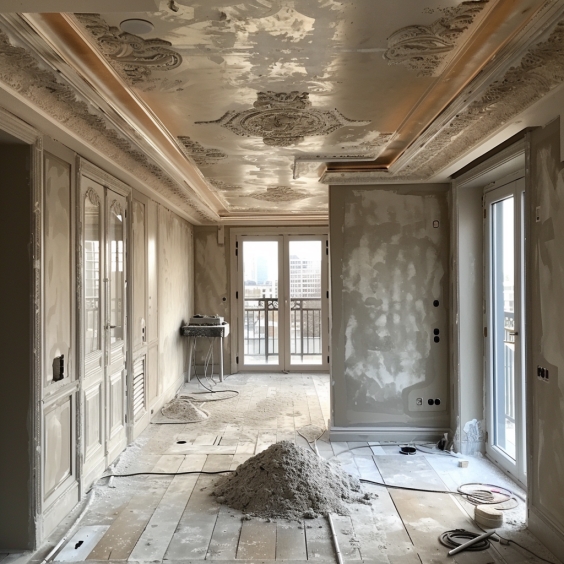以下に、左官工事に関する指摘事項と英会話例を記載します。
1.左官工事に関してよくある指摘事例
- Uneven surface finish (不均一な表面仕上げ)
- Incorrect mortar mix proportions (不適切なモルタル配合比)
- Inadequate curing of plaster (不十分な漆喰の養生)
- Cracking in plastered surfaces (漆喰面のひび割れ)
- Poor adhesion to substrate (下地への不十分な付着)
2.左官工事に関してよくある指摘事項とポイントを英語で説明する
まずは音声だけ聞いてみましょう。
Plastering is a crucial aspect of construction that affects both aesthetics and durability. Here are key points to remember:
- Surface preparation: Ensure the substrate is clean, free from dust, and properly primed. For concrete surfaces, achieve a suitable key through mechanical means or bonding agents.
- Mortar mix: Follow specified mix proportions carefully. Typical mix for base coat is 1:3 (cement:sand), while finish coat often uses 1:4 or 1:5. Adjust water content for proper workability.
- Application technique: Apply plaster in layers, typically 10-15mm for the base coat and 2-3mm for the finish coat. Use proper tools and techniques for even application and desired texture.
- Curing: Maintain proper moisture content during curing. Typically, moist cure for at least 7 days for cement-based plasters. Protect from rapid drying, especially in hot or windy conditions.
- Thickness control: Maintain consistent thickness across the surface. Use screeds and depth gauges to ensure uniformity. Total thickness usually ranges from 15-20mm.
- Joint treatment: Properly reinforce joints between different materials (e.g., masonry to concrete) with metal lath or fiber mesh to prevent cracking.
- Corner reinforcement: Use corner beads or reinforcing mesh at external corners to ensure straight, durable edges.
- Surface flatness: Check with a straightedge. Tolerance is typically ±3mm over a 2m length for walls, and ±2mm over 2m for ceilings.
Always refer to project specifications and local building codes, as requirements may vary based on climate, building type, and specific finish requirements.
日本語訳:
左官工事は、美観と耐久性の両方に影響を与える建設の重要な側面です。覚えておくべき重要なポイントは以下の通りです:
- 下地処理:下地が清浄で、埃がなく、適切にプライマー処理されていることを確認します。コンクリート面の場合、機械的手段または接着剤を使用して適切なキーを形成します。
- モルタル配合:指定された配合比を慎重に守ります。下塗りの典型的な配合は1:3(セメント:砂)で、上塗りは often 1:4または1:5を使用します。適切な作業性のために水量を調整します。
- 塗布技術:漆喰を層状に塗布します。通常、下塗りは10-15mm、上塗りは2-3mmです。均一な塗布と希望のテクスチャを得るために適切な道具と技術を使用します。
- 養生:養生中は適切な含水量を維持します。セメントベースの漆喰の場合、通常少なくとも7日間の湿潤養生を行います。特に暑いまたは風の強い条件下では、急速な乾燥から保護します。
- 厚さの管理:表面全体で一貫した厚さを維持します。均一性を確保するためにスクリードと深さゲージを使用します。全体の厚さは通常15-20mmの範囲です。
- 継ぎ目の処理:異なる材料間(例:レンガとコンクリート)の継ぎ目は、ひび割れを防ぐためにメタルラスまたはファイバーメッシュで適切に補強します。
- 角の補強:外部の角には、まっすぐで耐久性のあるエッジを確保するためにコーナービードまたは補強メッシュを使用します。
- 表面の平坦度:直定規でチェックします。通常、壁の場合は2mの長さで±3mm、天井の場合は2mで±2mmの許容誤差があります。
常にプロジェクト仕様書と地域の建築基準を参照してください。気候、建物の種類、特定の仕上げ要件によって要件が異なる場合があります。
3.左官工事に関する英会話例
次は英会話例です。こちらもまずは音声を聞いてみましょう。
Site Supervisor: I've been inspecting the plastering work in the lobby area. There are a few concerns we need to address.
Plasterer: I see. What specific issues have you noticed?
Site Supervisor: First, the surface finish seems uneven in some areas, particularly on the west wall. Have you been checking for flatness?
Plasterer: We've been using a straightedge, but perhaps we need to be more thorough. What's the tolerance we're working with?
Site Supervisor: For walls, we need to maintain ±3mm over a 2m length. Can you go back and check all areas with a 2m straightedge?
Plasterer: Certainly. We'll re-check and make any necessary adjustments. What other issues did you observe?
Site Supervisor: I'm also concerned about the mortar mix. The finish coat seems a bit too rich. What ratio are you using?
Plasterer: We've been using a 1:3 cement to sand ratio for the finish coat. Is that not correct?
Site Supervisor: For the finish coat, we typically want a leaner mix, around 1:4 or 1:5. A richer mix can lead to shrinkage cracks. Can you adjust this moving forward?
Plasterer: Absolutely. We'll modify our mix to 1:4 for the remaining areas. Should we re-do the areas already completed?
Site Supervisor: Let's monitor those areas closely for any cracking. If we see issues, we may need to re-do them. Now, about the curing process…
Plasterer: We've been letting it dry naturally. Is that not sufficient?
Site Supervisor: For proper curing, we need to keep the plaster moist for at least 7 days. Have you been mist spraying or using curing compounds?
Plasterer: We haven't been. We'll start mist spraying immediately. How often should we do this?
Site Supervisor: Aim for 2-3 times a day, especially in these warm conditions. Also, I noticed some potential adhesion issues near the ceiling-wall junction. Did you use any reinforcement there?
Plasterer: We didn't use any specific reinforcement in that area. Should we have?
Site Supervisor: Yes, it's a good practice to use fiber mesh or metal lath at junctions between different materials. It helps prevent cracking due to differential movement.
Plasterer: I see. We'll add reinforcement in those areas going forward. For the areas already done, should we apply a skim coat with embedded mesh?
Site Supervisor: That's a good solution. One last thing - are you using corner beads on the external corners?
Plasterer: We've been hand-forming the corners. Is that not acceptable?
Site Supervisor: While skilled plasterers can hand-form corners, using corner beads ensures consistency and durability. Let's use them for the remaining work.
Plasterer: Understood. We'll make all these adjustments immediately. Is there anything else we should be aware of?
Site Supervisor: That covers the main points. Remember, quality plastering is crucial for both the appearance and longevity of the building. Let's work together to ensure we meet the highest standards.
Plasterer: Agreed. We appreciate your thorough inspection. We'll implement these changes right away and maintain better quality control moving forward.
日本語訳:
現場監督: ロビーエリアの左官工事を点検していたんだが、対処すべき懸念事項がいくつかある。
左官工: なるほど。具体的にどのような問題に気づかれましたか?
現場監督: まず、表面の仕上がりが一部の区域で不均一に見える。特に西側の壁だ。平坦さをチェックしているのか?
左官工: 直定規を使用していましたが、もっと徹底する必要があるかもしれません。作業している許容誤差はどのくらいですか?
現場監督: 壁の場合、2mの長さで±3mmを維持する必要がある。2mの直定規ですべての区域を再確認できるか?
左官工: もちろんです。再確認して必要な調整を行います。他にどのような問題を観察されましたか?
現場監督: モルタルの配合についても懸念がある。上塗りが少し濃すぎるようだ。どのような比率を使用しているんだ?
左官工: 上塗りにはセメントと砂の比率1:3を使用していました。それは正しくないのでしょうか?
現場監督: 上塗りの場合、通常はより薄い配合、1:4か1:5程度が望ましい。濃い配合は収縮亀裂につながる可能性がある。今後、これを調整できるか?
左官工: もちろんです。残りの区域では1:4に配合を変更します。既に完了した区域はやり直すべきですか?
現場監督: それらの区域を亀裂がないか注意深く監視しよう。問題が見られれば、やり直す必要があるかもしれない。さて、養生プロセスについて…
左官工: 自然乾燥させていました。それでは不十分ですか?
現場監督: 適切な養生のためには、少なくとも7日間漆喰を湿った状態に保つ必要がある。ミスト噴霧や養生剤を使用していたか?
左官工: 使用していませんでした。すぐにミスト噴霧を開始します。どのくらいの頻度で行うべきですか?
現場監督: このような暖かい条件下では、1日2-3回を目指してくれ。また、天井と壁の接合部付近で潜在的な付着の問題に気づいた。そこに何か補強を使用したか?
左官工: その区域には特別な補強を使用しませんでした。使用すべきでしたか?
現場監督: ああ、異なる材料の接合部にはファイバーメッシュやメタルラスを使用するのが良い方法だ。差動移動によるひび割れを防ぐのに役立つ。
左官工: なるほど。今後はそれらの区域に補強を追加します。既に完了した区域については、メッシュを埋め込んだスキムコートを適用すべきですか?
現場監督: それは良い解決策だ。最後にもう一つ - 外部の角にはコーナービードを使用しているか?
左官工: 角は手作業で形成していました。それは許容されないのですか?
現場監督: 熟練した左官職人は手作業で角を形成できるが、コーナービードを使用すれば一貫性と耐久性が確保できる。残りの作業ではそれらを使用しよう。
左官工: 理解しました。これらの調整をすぐに行います。他に注意すべきことはありますか?
現場監督: 主なポイントはこれで全てだ。質の高い左官工事は、建物の外観と長寿命化の両方にとって重要だということを覚えておいてくれ。最高の基準を満たすために一緒に働こう。
左官工: 同意します。徹底的な検査に感謝します。これらの変更をすぐに実施し、今後はより良い品質管理を維持します。






